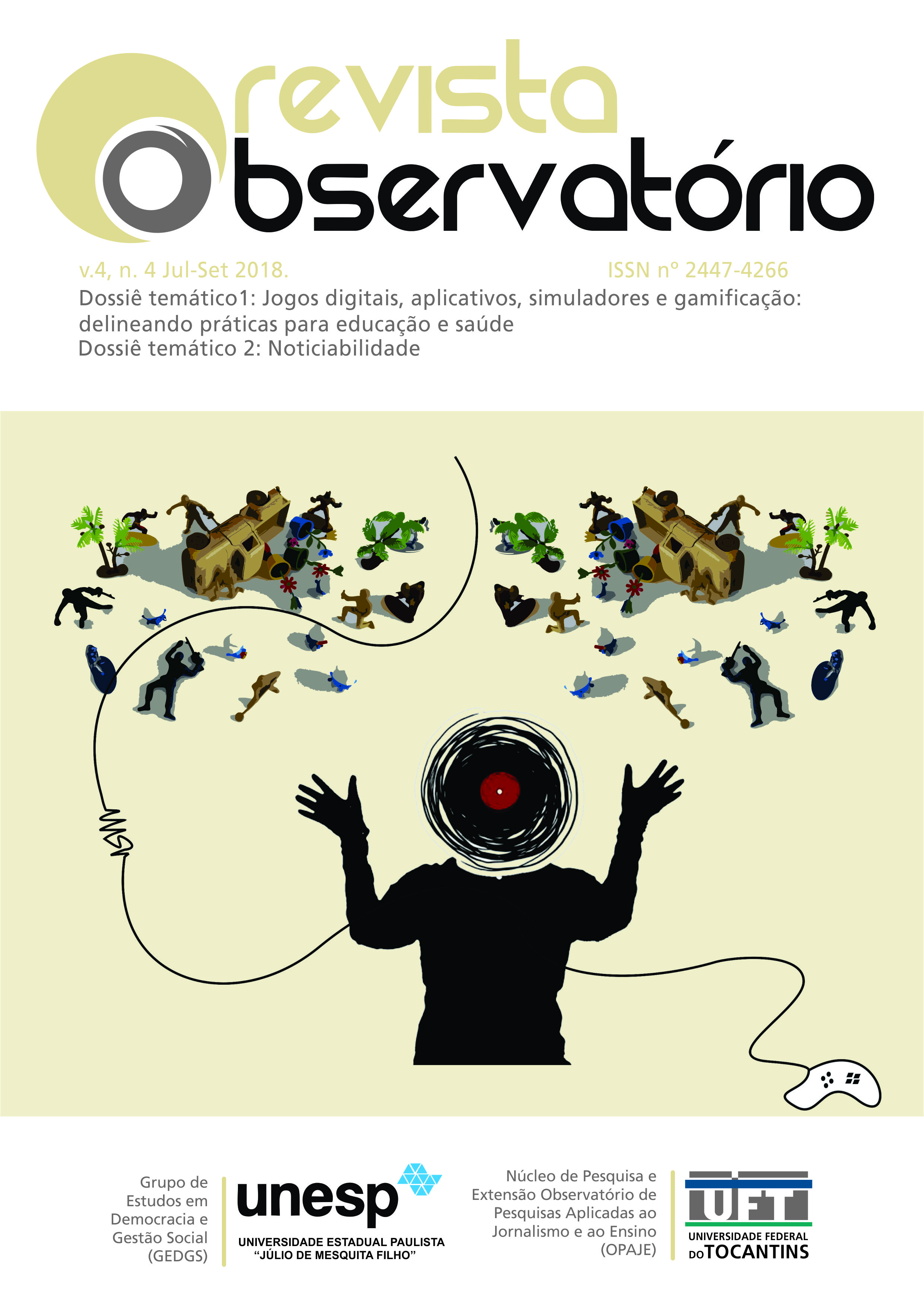GAMIFICAÇÃO NO ENSINO: casos bem-sucedidos
DOI:
https://doi.org/10.20873/uft.2447-4266.2018v4n4p246Palavras-chave:
Gamificação, Ferramentas digitais, Processo de ensino-aprendizagem, Práticas PedagógicasResumo
A gamificação tem vindo a ser integrada nas práticas educativas de alguns professores, provocando mudanças que promovem a motivação e o envolvimento dos alunos nas tarefas propostas. Para proporcionar emoções similares às que os jovens procuram nos jogos, podem ser utilizadas diferentes ferramentas digitais que se vão referir ao longo das descrições dos casos. Neste artigo procede-se ao enquadramento teórico sobre o conceito de gamificação e à sua aplicação no ensino, apresentando o modelo Octalysis. De seguida, reportam-se exemplos desenvolvidos e aplicados em sala de aula por professores, que podem ser replicados, proporcionando aos alunos novas experiências e emoções, envolvendo-os no processo de aprendizagem.
Downloads
Referências
ARAÚJO, I. Gamification: metodologia para envolver e motivar alunos no processo de aprendizagem. Education in the Knowledge Society (EKS), v. 16, n. 1, p. 87-108, 2015.
ARAÚJO, I.; CARVALHO, A. A. Capacitar professores para o uso da gamificação. 19º Simpósio Internacional de Computadores na Educação (SIIE) (pp. 264-269). Lisboa: ESEL (IPL), 2017.
BURKE, B. GAMIFY: How Gamification Motivates People to do Extraordinary Things. EUA: Gartner, Inc., 2014.
CARVALHO, A. A. Jogos digitais e gamificação: desafios e competição para aprender na era MobileLearning. In: Aprendizagem, TIC e Redes digitais (pp. 112-144). Lisboa: Conselho Nacional de Educação, 2017.
CARVALHO, A. A.; MACHADO, C. T. Flipped Classroom e Quizzes como Motivadores de Aprendizagem: perspetivas dos estudantes universitários. CISTI'2017 - 12ª Conferência Ibérica de Sistemas e Tecnologias de Informação (pp. 752-757), 2017. DOI:10.23919/CISTI.2017.7975851
CHOU, Y. Actionable Gamification: Beyond Points, Badges, and Leaderboards. Octalysis Media, 2015.
DECI, E. L.; RYAN, R. M. The “What” and “Why” of Goal Pursuits: Human Needs and the Self-Determination of Behavior on JSTOR. Psychological Inquiry, v. 11, n. 4, p. 227–268, 2000.
DETERDING, S. et al. From game design elements to gamefulness: Defining “Gamification”. Proceedings of the 15th Conference on Envisioning Future Media Environments - MindTrek ’11. New York, USA: ACM Press, 2011.
GEE, J. P. What Video Games have to teach us about learning and literacy. EUA: Palgrave Macmillan, 2003.
HAMARI, J.; KOIVISTO, J.; SARSA, H. Does Gamification Work? — A Literature Review of Empirical Studies on Gamification. Proceedings of the 47th Hawaii International Conference on System Sciences (HICSS). Waikoloa, HI, USA: IEEE, 2014.
JOHNSON, L. et al. NMC Horizon Report: 2014 Higher Education Edition. Austin, Texas: NMC, 2014.
KAPP, K. M. The Gamification of Learning and Instruction: Game-based methods and strategies for training and education. San Francisco: Pfeiffer, 2012.
KOSTER, R. The Theory of Fun for Game Design. EUA: Paraglyph Press, 2005.
MALLIET, S.; MEYER, G. DE. The History of the Video Game. In: RAESSENS, J.; GOLDSTEIN, J. (Eds.). Handbook of Computer Game Studies. London: The MIT Press, 2005. p. 25–45.
MARCZEWSKI, A. What’s the difference between Gamification and Serious Games? Disponível em: http://www.gamified.co.uk/2013/02/25/gamification-and-serious-games/#.VFJ-cTSsWSp.
MCGONIGAL, J. Reality is Broken - Why games make us better and how they can change the world. New York: Penguin Books, 2011.
MOURA, A. Metodologias de Aprendizagem que desafiam os alunos, mediadas por tecnologias digitais. Revista Observatório, v. 3, n. 4, p. 256–278, 1 jul. 2017.
REEVES, B.; READ, J. L. Total Engagement: How Games and Virtual Worlds Are Changing the Way People Work and Businesses Compete. Boston, Massachusetts: Harvard Business Press, 2009.
SANTOS, I.; GUIMARÃES; D.; CARVALHO, A. A. Flipped Classroom: Uma Experiência Com Alunos do 8º Ano na Unidade de Sólidos Geométricos. In G. L. Miranda, M. E. Monteiro, & P. T. Brás (Orgs). TICEduca'2104 - III Congresso Internacional TIC e Educação (pp. 338-342). Lisboa, Portugal: Instituto de Educação da Universidade de Lisboa, 2014.
SCHELL, J. The Art of Game Design - A book of Lenses. EUA: CRC Press, 2008.
SCHELL, J. Design Outside the Box. DICE 2010. G4, 2010. Disponível em: http://www.g4tv.com/videos/44277/DICE-2010-Design-Outside-the-Box-Presentation/
SQUIRE, K. D. Video Games and Learning - Teaching and Participatory Culture in the digital age. New York: Teachers College, Columbia University, 2011.
TONDELLO, G. F. et al. Heuristic Evaluation for Gameful Design. Proceedings of the 2016 Annual Symposium on Computer-Human Interaction - CHI PLAY Companion’16. New York, USA: ACM Press, 2016.
XU, Y. Literature Review on Web Application Gamification and Analytics. Honolulu: University of Hawai‘i, 2012. Disponível em: http://csdl.ics.hawaii.edu/techreports/11-05/11-05.pdf.
ZAGALO, N.; CARVALHO, A. A.; ARAÚJO, I. Elementos do design de videojogos que fomentam o interesse dos jogadores. Revista ESC - Educação, Sociedade & Culturas, v. 48, n. February 2017, p. 169–190, 2016.
ZICHERMANN, G.; LINDER, J. The Gamification Revolution: how leaders leverage game mechanics to crush the competition. EUA: Mc Graw Hill Education, 2013.
ZIMMERMAN, E. Gaming literacy: Game Design as a Model for Literacy in the Twenty-First Century. In: The Video Game Theory Reader 2. New York: Routledge, 2008.
Publicado
Como Citar
Edição
Seção
Licença
[PT] Autores que publicam nesta revista concordam com os seguintes termos:
1. Autores mantém os direitos autorais e concedem à revista, sem pagamento, o direito de primeira publicação, com o trabalho simultaneamente licenciado sob a Creative Commons Attribution License (CC BY-NC 4.0), permitindo o compartilhamento do trabalho com reconhecimento da autoria do trabalho e publicação inicial nesta revista.
Leia todos os termos dos direitos autorais aqui.


